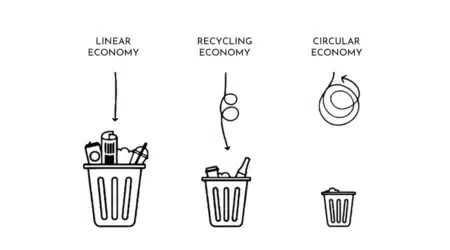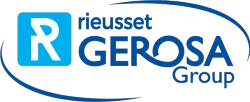
22 Jul The circular economy in Rieusset: A commitment to sustainability
Index of contents:
In a world where natural resources are finite and sustainability is more crucial than ever, the circular economy is an indispensable strategy for companies wishing to minimize their environmental impact. In the GEROSA group, and in particular at Rieusset, we are deeply committed to caring for the environment, implementing various sustainability policies that are aligned with the principles of the circular economy.
The circular economy: A model of regeneration and efficiency
The linear economy is the traditional model on which much of industry is based: extracting materials, production, consuming and disposal. Analyzing the linear economy model is crucial because only by understanding its limitations and consequences can we effectively plan and execute our transition to more sustainable models, such as the recycling economy and the circular economy.
At Rieusset, we currently operate in a recycling economy, reusing materials to reduce environmental impact. Our ultimate goal is to evolve towards a circular economy, a system that promotes the constant reuse and recycling of resources, significantly reducing waste and promoting long-term sustainability.

Via Anew
The circular economy is a production and consumption model that involves sharing, renting, reusing, repairing, renewing and recycling existing materials and products as many times as possible. This continuous cycle of reuse helps minimize waste, extending the useful life of products and reducing the need to extract new resources. The following Ellen MacArthur Foundation butterfly diagram illustrates this concept clearly, highlighting key flows such as renewable resource management, finite materials management and waste reduction.
Rieusset and eco-design
The main strategy for achieving commitment to the circular economy is called eco-design; in fact, the circular economy is eco-design taken to the extreme. But eco-design isn’t the only thing we do at Rieusset. There are also other measures in favor of the circular economy that we have adopted in Rieusset:
1. Waste classification and management: One of our outstanding practices is the meticulous classification of waste. The new managers who evaluate our waste always highlight our rigorous separation by waste type and EWL code (European Waste List). This approach makes it possible to identify the most appropriate treatment for each type of waste, favoring recycling and reuse rather than simple disposal.
2. Increased use of recycled material: We are focused on analyzing in depth the waste that ends up in the banal or general waste container, which is where we deposit the waste for which we have no clear management. This analysis allows us to identify opportunities to increase the percentage of recycled material, focusing on the effective separation and recycling of materials. For example, some of the ink containers in our printing operations were being disposed of as ordinary waste; from now on, they will be correctly separated.
3. Collection and separation of cardboard: In our factory, the water points used to be accompanied by general waste containers in which to dispose of the used paper cups. We have replaced the ordinary waste containers at these points with cardboard containers to correctly collect these cups, facilitating their recycling. This action ensures that the cardboard is effectively recovered, preventing it from being mixed with other waste and losing its recycling potential.
4. Reusing resources: Before considering recycling, we prioritize reuse. One example is the reuse of paper with printing on only one side, using the other side for internal printing. In addition, the pallets we receive with raw materials that are in good condition are reused to distribute our products, while those in poor condition are used internally and those we do not need are conditioned by our waste manager for a second life.
Another action taken by Rieusset is the reuse of ink, adhesive and chemical containers. In a graphic arts industry, hazardous waste is very common, so reusing this hazardous waste can be a real challenge. With the cooperation of our suppliers, many of the ink and adhesive containers that come to us for the manufacturing of our products are now returned, thus allowing the container to be reused multiple times between the supplier and Rieusset.
5. Efficiency in the use of resources: Eco-design seeks to optimize the use of resources, reducing the consumption of raw materials and energy, which is fundamental to the efficiency of the circular economy. At Rieusset, we are constantly working to reduce gas, energy and water consumption. In addition, we are analyzing our products to use less raw material during our production process.
Our commitment to the circular economy
At Rieusset, the circular economy is more than a philosophy; it is a daily practice that guides our operations and decisions. From rigorous waste sorting to material reuse, we are dedicated to reducing our environmental impact and fostering a more sustainable life cycle for our products.
As Àngela Berbis, Sustainability Technician at Rieusset, explains, “It is crucial for our commitment to be comprehensive and cover the entire chain of our products. I am aware of the challenge this represents, which is why the participation of our stakeholders is essential in our day-to-day work. They not only support, but also propose significant improvements. Without this collaboration, the path to a more present circular economy would not be possible.”
Our commitment to the circular economy also aligns with the growing expectations of consumers and our clients, who increasingly value sustainable practices. By incorporating these principles into our daily operations, we not only respond to these expectations, but also lead the way toward a more sustainable future.
Moreover, the adoption of these circular economy practices not only contributes to environmental sustainability, but also offers economic and operational benefits. The reduction of waste and the efficient use of resources result in significant savings and a more efficient operation. By following these principles, we not only contribute to the preservation of the environment, but also demonstrate that sustainability and economic efficiency can go hand in hand.
At Rieusset, we believe that the transition to a circular economy is not only a responsibility, but an opportunity to build a more sustainable, safer and healthier future. We will continue to innovate and improve our practices to ensure that we remain a sustainability leader in the label, flexible packaging and sleeve printing industry.
| We Manufacture: | Meet Rieusset: |



